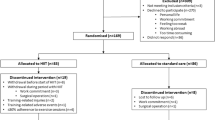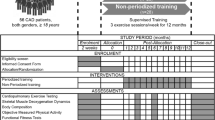Summary
Cardiovascular disease is the leading cause of morbidity and mortality in most of the industrialised nations in the world. Many treatment strategies are used for patients with coronary artery disease. One of these strategies is the use of cardiac exercise rehabilitation.
The traditional approach to cardiac exercise rehabilitation has been the training of large muscle groups using aerobic activities such as cycling or walking. These types of activities have been demonstrated to improve maximal exercise performance and endurance. However, although aerobic performance is improved it does not address another very important component of exercise rehabilitation — namely muscular strength.
Weightlifting training has been demonstrated to improve muscular strength in healthy individuals. Until recently this form of exercise training of patients with cardiac disease has been avoided due to the haemodynamic response observed during isometric (static) exercise.
Weightlifting has recently been demonstrated not to be a pure isometric exercise and a different haemodynamic response has been found even in patients with cardiac disease. For this reason studies of weightlifting training have been performed in selected groups of patients with coronary artery disease. The results of these studies in this limited group of patients have demonstrated the activity is safe and beneficial in terms of improving the patient’s functional capacity. Weightlifting training may also favourably affect the risk factors for coronary artery disease.
Based on studies reviewed in this paper, recommendations can be made for the weightlifting training of patients with coronary artery disease. These include restriction to patients who are asymptomatic or only mildly symptomatic; initiation of training only after a period of aerobic training; the use of single limb activities; a maximum intensity no greater than 60% of 1 repetition maximum; patients train at their own rate; initially performed in a medically supervised programme; periodic reassessment of the exercise prescription; and patients should record their heart rate and response to exercise.
Similar content being viewed by others
References
Asmussen E. Similarities and dissimilarities between static and dynamic exercise. Circulation Research 48(Suppl. 1): I–3–I–10, 1981
Bezucha GR, Lenser MC, Hanson PG, Nagle FJ. Comparison of hemodynamic responses to static and dynamic exercise. Journal of Applied Physiology 53: 1589–1593, 1982
Butler RM, Beierwaltes WH, Rogers FJ. The cardiovascular response to circuit weight training in patients with cardiac disease. Journal of Cardiopulmonary Rehabilitation 7: 402–409, 1987
Clausen JP, Trap-Jensen J. Effects of training on the distribution of cardiac output in patients with coronary artery disease. Circulation 42: 611, 1970
Clausen JP, Klausen K, Rasmussen B, Trap-Jensen J. Central and peripheral circulatory changes after training of the arms or legs. American Journal of Physiology 225: 675–682, 1973
Clausen JP, Trap-Jensen J. Effects of training on the distribution of cardiac output in patients with coronary artery disease. Circulation 42: 611, 1970
Crozier-Ghilarducci LE, Holly RG, Amsterdam EA. Effects of high resistance training in coronary artery disease. American Journal of Cardiology 64: 866–870, 1989 culation 58: 368–375, 1978
Detry JRM, Rousseau M, Vandenbroucke G, Kusumi F, Brasseur LA, et al. Increased arteriovenous oxygen difference after physical training in coronary heart disease. Circulation 44: 109–118, 1971
Featherston JF, Holly RG, Amsterdam EA. Physiological responses to weight lifting in cardiac patients. Medicine and Science in Sports and Exercise 19: S93, 1987
Frick MH, Katila M. Hemodynamic consequences of physical training after myocardial infarction. Circulation 37: 192–202, 1968
Fripp RR, Hodgson JL. Effect of resistive training on plasma lipid and lipoprotein levels in male adolescents. Journal of Pediatrics 111: 926–931, 1987
Gettman LR, Ayres JJ, Pollock ML, Jackson A. The effect of circuit weight training on strength cardiorespiratory function and body composition of adult men. Medicine and Science in Sportsand Exercise 10: 171–176, 1978
Goldberg LE, Elliot DL, Schulz RW, Kloster FE. Changes in lipid and lipoprotein levels after weight-training. Journal of the American Medical Association 252: 504–506, 1984
Grossman W, McLaurin LP, Saltz SB, Paraskos JA, Dalen JE, et al. Changes in the inotropic state of the left ventricle during isometric exercise. British Heart Journal 35: 697–704, 1973
Hagberg JM, Ehsani AA, Holloszy JO. Effect of 12 months of intense exercise training on stroke volume in patients with coronary artery disease. Circulation 67: 1194–1199, 1983
Hanson P, Nagle F. Isometric exercise: cardiovascular responses in normal and cardiac populations. Cardiology Clinics 5: 157–170, 1987
Harris KA, Holly RG. Physiological response to circuit weight training in borderline hypertensive subjects. Medicine and Science in Sports and Exercise 19: 246–252, 1987
Haslam D, McCartney N, McKelvie RS, Sale DG, Jones NL. Weight training in cardiac patients. Medicine and Science in Sports and Exercise 20: S90, 1988a
Haslam RS, McCartney N, McKelvie RS, MacDougall JD. Direct measurements of arterial blood pressure during formal weightlifting in cardiac patients. Journal of Cardiopulmonary Rehabilitation 8: 213–225, 1988b
Heifant RH, De Villa MA, Meister S. Effect of sustained isometric handgrip exercise on left ventricular performance. Circulation 44: 982–993, 1971
Hurley BF, Hagberg JM, Goldberg AP, Seals DR, Ehsani AA, et al. Resistance training can reduce coronary risk factors without altering VO2max or percent body fat. Medicine and Science in Sports and Exercise 20: 150–154, 1988
Johnson CC, Stone MH, Lopez SA, Hergberg JA, Kilgore TL, et al. Diet and exercise in middle-aged men. Journal of the American Dietetic Association 81: 695–701, 1982
Kelemen MH, Stewart KJ, Gillilan RE, Ewart GK, Valenti SA, et al. Circuit weight training in cardiac patients. Journal of the American College of Cardiology 7: 38–42, 1986
Kerber RE, Miller RA, Najjar SM. Myocardial isch00E9mie effects of isometric dynamic and combined exercise in coronary artery disease. Chest 67: 388–394, 1975
Kilbom A, Persson J. Cardiovascular response to combined dynamic and static exercise. Circulation Research 48: I–93–I–97, 1981
Kivowitz C, Parmley W, Donoso R, Marcus H, Ganz W, et al. Effects of isometric exercise on cardiac performance: the grip test. Circulation 44: 994–1002, 1971
Kokkinos PF, Hurley BF, Smutok MA, Farner C, Reece C, et al. Lipoprotein-lipid profiles and post-heparin lipase activities are unaltered from strength training. Medicine and Science in Sports and Exercise 21: SI 16, 1989
Kokkinos PF, Hurley BF, Vaccaro P, Patterson JC, Gardner LB, et al. Effects of low- and high-repetition resistive training on lipoprotein-lipid profiles. Medicine and Science in Sports and Exercise 20: 50–54, 1988
Longhurst JC, Kelly AR, Gonyeu WJ, Mitchell JH. Chronic training with static and dynamic exercise: cardiovascular adaptation, and response to exercise. Circulation Research 48(Suppl. 1): 1171–1178, 1981
MacDougall JD, Tuxen D, Sale DG, Moroz JR, Sutton JR. Arterial blood pressure response to heavy resistance exercise. Journal of Applied Physiology 58: 785–790, 1985
McCartney N, Martin J, McKelvie RS, MacDougall JD, Sale DG. Weight training induced attenuation of the pressor response to weightlifting in older males. Medicine and Science in Sports and Exercise 21: S2, 1989b
McCartney N, Oldridge NB, Hicks A, Jones NL. Maximal isokinetic cycle ergometry in patients with coronary artery disease. Medicine and Science in Sports and Exercise 21: 313–318, 1989a
Miller WJ, Sherman WM, Ivy JL. Effect of strength training on glucose tolerance and post-glucose insulin response. Medicine and Science in Sports Exercise 16: 539–543, 1984
Mitchell JH, Wildenthal K. Static (isometric) exercise and the heart: physiological and clinical considerations. Annual Review of Medicine 24: 269–381, 1974
O’Connor GT, Buring JE, Yusuf S, Goldhaber SZ, Olmstead EM, et al. An overview of randomized trials of rehabilitation with exercise after myocardial infarction. Circulation 80: 234–244, 1989
Oldridge NB, Guyatt GH, Fischer MS, Rimm AA. Cardiac rehabilitation after myocardial infarction: combined experience of randomized clinical trials. Journal of the American Medical Association 260: 945–950, 1988
Oldridge NB, McCartney N, Hicks A, Jones NL. Improvement in maximal isokinetic cycle ergometry with cardiac rehabilitation. Medicine and Science in Sports and Exercise 21: 308–312, 1989
Paulsen WJ, Boughner DR, Friesen A, Persaud JA. Ventricular response to isometric and isotonic exercise. Echocardiographic assessment. British Heart Journal 42: 521–527, 1979
Perez-Gonzales JF, Schiller NB, Parmley WW. Direct and non-invasive evaluation of the cardiovascular response to isometric exercise. Circulation Research 48(Suppl. 1): 1138–1148, 1981
Sagiv M, Hanson P, Besozzi M, Nagle F. Left ventricular responses to upright isometric handgrip and deadlift in men with coronary artery disease. American Journal of Cardiology 55: 1298–1302, 1985
Sheldhal LM, Wilke NA, Tristani FE, Kalbfleisch JH. Response of patients after myocardial infarction to carrying a graded series of weight loads. American Journal of Cardiology 52: 698–703, 1983
Sheldhal LM, Wilke NA, Tristani FE, Kalbfleisch JH. Responses to repetitive static-dynamic exercise in patients with coronary artery disease. Journal of Cardiac Rehabilitation 5: 139–145, 1985
Stewart KJ, Mason M, Kelemen MH. Three-year participation in circuit weight training improves muscular strength and selfefficacy in cardiac patients. Journal of Cardiopulmonary Rehabilitation 8: 292–296, 1988
Stone MH, Blessing D, Byrd R, Tew J, Boatwright D. Physiological effects of a short term resistive training program on middle-aged untrained men. National Strength and Conditioning Association Journal (October–November): 16–20, 1982
Stout RW. Overview of the association between insulin and atherosclerosis. Metabolism 34 (Suppl.): 7–12, 1985
Ulrich IH, Reid CM, Yeater RA. Increased HDL-cholesterol levels with a weight-training program. Southern Medical Journal 80: 328–331, 1987
Vander LB, Franklin BA, Wrisley D, Rubenfire M. Acute cardiovascular response to circuit weight training in patients with cardiac disease. Annals of Sports Medicine 2: 165–169, 1986
Vecht RJ, Graham GWS, Sever PS. Plasma noradrenaline concentrations during isometric exercise. British Heart Journal 40: 1216–1220, 1978
Weltman A, Janney C, Rians CB, Strand K, Katch FI. The effects of hydraulic resistance strength training on serum lipid levels in prepubertal boys. American Journal of Diseases in Children 141: 777–780, 1987
Wiecek EM, McCartney N, McKelvie RS. A comparison of direct and indirect measures of arterial pressure during weightlifting in patients with coronary artery disease. American Journal of Cardiology, in press, 1990
Wilke NA, Sheldhal LM, Levandoski SG, Hoffman MD, Tristani FE. Weight carrying versus handgrip exercise testing in men with coronary artery disease. American Journal of Cardiology 64: 736–740, 1989
Wilke NA, Sheldhal LM, Tristani FE, Hughes CV. The safety of static-dynamic effort soon after myocardial infarction. American Heart Journal 110: 542–545, 1985
Author information
Authors and Affiliations
Rights and permissions
About this article
Cite this article
McKelvie, R.S., McCartney, N. Weightlifting Training in Cardiac Patients. Sports Med 10, 355–364 (1990). https://doi.org/10.2165/00007256-199010060-00003
Published:
Issue Date:
DOI: https://doi.org/10.2165/00007256-199010060-00003




